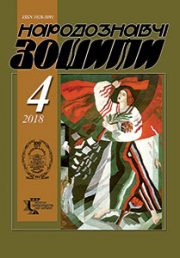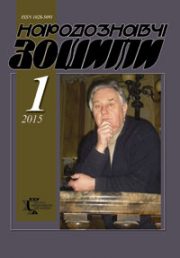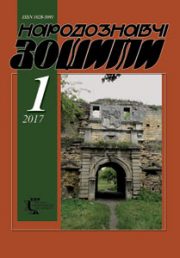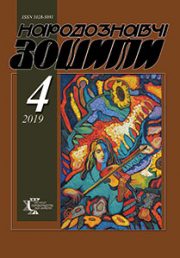The Ethnology Notebooks. 2020. № 3 (153), 573—584
UDK 398(=161.2):314.151.3-054.74(=161.2)(438)
DOI https://doi.org/10.15407/nz2020.03.573
KACHMAR Maria
ORCID ID: https://orcid.org/0000-0002-7811-9576
Candidate of Sciences in Philology; Research Fellow
at the Institute of Ethnology
of the National Academy of Sciences of Ukraine,
15 Svobody Avenue, 79000, Lviv, Ukraine.
Contacts: e-mail: mariakachmar@ukr.net
Abstract. The study of the phenomenon of the interaction of history and oral literature is especially relevant today and remains one of the leading areas of folklore discourse. The article is devoted to the analysis of folk tales of Ukrainians, deported in 1944—1945 from Zakerzonnya (4 districts of Poland). The object and source base of the research are the texts of folk tales about resettlement, recorded in 2012 from the residents of the villageTulyholove of Horodok district of Lviv region, natives of villages of Yaroslavl and Przemyњl districts of Poland. The purpose of the article is to outline thematic groups and plot motives on the basis of the analysis of folklore narratives about the deportation of Ukrainians from Zakerzonnya, which were introduced into scientific circulation for the first time; find out their semantics and genesis; explore the dominant images, that best represent the «small» homeland and the «new» home; trace the specifics of the reflection of objective historical events through the subjective perception of the participant or eyewitness. The methodological basis of the work is the principle of historicism of folklore. The works of Ukrainian folklorists in the field of interaction of history and folk art (S. Myshanych, V. Sokol, L. Ivannikova, O. Kuzmenko, L. Khalyuk, etc.) are used.
On the basis of a comprehensive study of prose samples the subject, structure, basic motives, central images, the source of which undoubtedly served certain historical events, reflected through the prism of individual experiences and feelings, collective memory and folklore consciousness are analysed. Three thematic blocks are distinguished: life in a small homeland before resettlement (idealization of home, everyday life and holidays, relations with Polish neighbors, Polish-Ukrainian conflict), organization and course of resettlement (reasons for deportation, participation of the Ukrainian national underground, inhumane conditions and the hard road to a new land), the organization of life in Ukraine (the development of a new space, consolidation through religion). Attention is drawn to the idealization of the small homeland, which is associated with a happy childhood, flat land and fertile fields, the Sian River, warm memories of celebrating Christmas, Easter. The new home is associated in respondents with semi-collapsed smoking houses, poverty, decline, chaos. One of the important factors of community consolidation in the new land is the church. Structural-typological, structural-semiotic, textual, comparative, interdisciplinary methods, field research method were used. The introduction into scientific circulation of valuable folklore materials, recorded from direct eyewitnesses of the events, natives of Zakerzonnya, is a novelty of the study.
Keywords: narrative, deportation, motive, small homeland, idealization, collective memory, folk consciousness.
Received 20.05.2020
REFERENCES
Myhanych, S.V. (1986). Oral folk stories.The question of poetics. Kyiv: Naukova dumka [in Ukrainian].
Myshanych, S. (1986). Oral Chronicles of People’s Life. In S. Myshanych (Ed.), Folk stories (Pp. 5—16). Kyiv: Dnipro [in Ukrainian].
Sokil, V. (2017). Folklore prose about the Holodomor of the twentieth century in Ukraine: the paradigm of the text. Monograph. Lviv: Institute of Ethnology of the National Academy of Sciences of Ukraine [in Ukrainian].
Ivannikova, L. (2016). Dnipropetrovsk — Polovitsa — Kodak: folklore and historical memory. Folklore and ethnology, 3, 42—50 [in Ukrainian].
Khaliuk, L.M. (2013). Oral folk tales of Ukrainian immigrants of Lemkivshchyna, Kholmshchyna, Pidliashshia and Nadsiannia: genre-thematic specificity, artistic features. Kyiv: M.T. Rylsky Institute of Art; Folklore Studies and Ethnology Institute of the National Academy of Sciences of Ukraine [in Ukrainian].
Kuzmenko, O. (2010). Concept of Motherland in the paradigm of artistic images of space in folk novelties about eviction (on the basis of their own records from the West Boykivshchyna). In Literature. Folklore. Problems of poetics (Vol. 34, pp. 210—220). Kyiv [in Ukrainian].
Kyrchiv, R. (2010). The twentieth century in Ukrainian folklore. Lviv: Institute of Ethnology of the National Academy of Sciences of Ukraine [in Ukrainian].
Drozd, R., & Halchak, B. (2013). History of Ukrainians in Poland in 1921—1989. Kharkiv: Gold Pages [in Ukrainian].
Vynogradska, G. (2008). Deportations of Ukrainians from Poland in 1944—1947: problems of periodization and the circumstances of resettlement (based on the materials of oral deportees). In East/West: historical and cultural collection. Special edition (Vol. 11—12, pp. 243—250) [in Ukrainian].
Kovalchuk, S., & Petrova, N. (2018). Ukrainians of the western frontier in the resettlement processes on the Odesa region in the second half of the 40’s of the twentieth century (on materials of the State Archives of the Odesa region). In Ukrainian borderland: variability of traditional culture. Odessa ethnographic readings: collection of scientific works (Pp. 131—140). Odesa: Odesa National University named after I.I. Mechnikov [in Ukrainian].
Pavliv, Yu.Z. (2018). Deportation of Ukrainians from the Polish-Ukrainian border area in 1944—1951 in the regional memory of Ukraine. The thesis for the academic degree of Candidate of Historical Sciences. Lviv [in Ukrainian].
Slyvka, Yu. (Ed.) (1996). Deportations: Western lands of Ukraine in the late 30’s — early 50’s. Documents, materials, memoirs: in three volumes (Vol. 1). Lviv: Institute of Ukrainian Studies named after I. Krypiakevych of the National Academy of Sciences of Ukraine [in Ukrainian].
In the millstones of history. Collection of memoirs and documents (2017). Kyiv: Gramnma [in Ukrainian].
Protsiuk, V. (Ed.). (2004). The book of memory. 1944—2014: the 60th anniversary of the Polish-Ukrainian bloody events on Zakerzonnia. Lviv [in Ukrainian].
Hlushko, M. (2017). Nadsiannia: localization and boundaries of the ethnographic region of Ukraine. Folklore and ethnology, 3, 7—15 [in Ukrainian].
Serhiychuk, V. (1997). Tragedy of Ukrainians in Poland. Ternopil: Book and magazine publishing house «Ternopil» [in Ukrainian].
Vyatrovych, V.M. (2011). Second Polish-Ukrainian War. 1942—1947. Kyiv: Kyiv-Mohyla Academy [in Ukrainian].
Truhan, M. (1990). Ukrainians in Poland after the Second World War (1944—1984). In Notes of the Shevchenko Scientific Society (Vol. 208). New York; Paris; Sydney; Toronto [in Ukrainian].
Snihiryova, L. Symbols of water, fire, wind, earth in Ukrainian folk historical songs of the 15th — early 18th centuries. Retrieved from: http://er.nau.edu.ua/bitstream/NAU/13584/1/%D0%A1%D0%A2%D0% 90%D0%A2%D0%A2%D0%AF%20%D0 % A1% D0% B8% D0% BC% D0% B2% D0% BE% D0% BB% D0% B8% 20% D0% B2% D0% BE% D0% B4% D0% B0 ….% D0 % A1% D0% BD% D0% B3% D0% B8% D1% 80% D1% 8C% D0% BE% D0% B2% D0% B0% 20% D0% 9B.% D0% 9C..pdf
Vygovsky, M., & Kucher, V. (1994). Zakerzonnia. Kyiv antiquity: popular scientific and literary magazine, 1, 94—102 [in Ukrainian].
Volynets, O. (2017). Religious factor in the Ukrainian ethno-creation (on the example of the UGCC). In Ukrainian national idea: realities and prospects of development (Vol. 17, pp. 54—58) [in Ukrainian].







